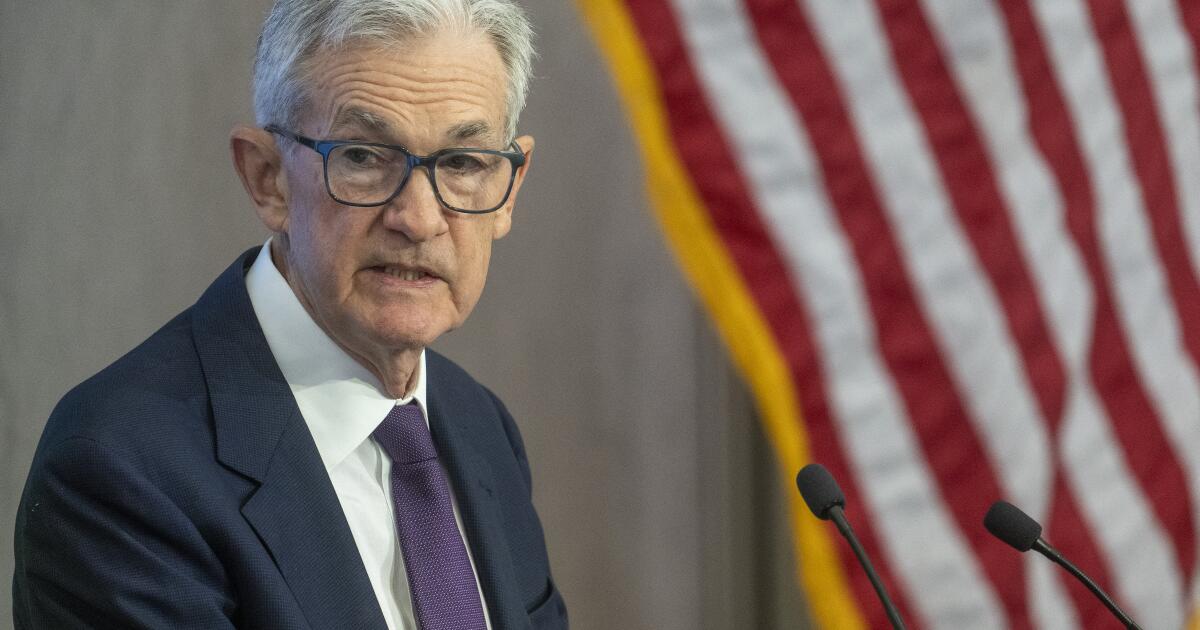Hiltzik: Do you really want Trump directing monetary policy?
It’s probably safe to say that almost no one following the news believes that Donald Trump has a solid, defensible reason to fire Federal Reserve Board Governor Lisa Cook, as he purported to do Monday, notwithstanding his assertion that she is guilty of “potentially criminal conduct.”
It’s not only that the charge she falsified information on mortgage applications is unproven, or that even on their face the accusations are thinner than onion-skin paper.
It’s that Trump has telegraphed his true objective loud and clear virtually from the inception of his current term: to destroy the Fed’s independence so he can force it to act in accordance with what he sees as his immediate political advantage, chiefly by cutting interest rates at a time when that would be economically irrational.
No one’s claiming that central bankers are going to be perfect at their jobs. What we’re saying is that they’re going to be better than the alternative.
— Peter Conti-Brown, Wharton School
He has pursued this objective in several ways. He has consistently denigrated the work of Fed Chairman Jerome Powell, questioning why Powell was ever appointed (and forgetting that he was the president who appointed Powell).
He has carried on about the cost of a renovation of the Fed’s Washington headquarters building, even misrepresenting the cost and nature of the project, suggesting that it points to Powell’s managerial ineptitude.
Newsletter
Get the latest from Michael Hiltzik
Commentary on economics and more from a Pulitzer Prize winner.
You may occasionally receive promotional content from the Los Angeles Times.
And now he’s trying to fire Cook, one of Powell’s supporters on the Fed board. Whether he can do so in the face of Cook’s refusal to go is unclear, and likely to be judged on by the Supreme Court.
That leads us to the principle of Federal Reserve independence and its critical importance for the health of the U.S. economy.
The Fed isn’t the only central bank that cherishes its independence. Most central banks in developed countries do too, although they solidified their status at different times — the Bank of England gaining operational independence over monetary policy in Britain only in 1997.
To be fair, the character of central bank independence has always been murky. “Central banks do not and should not operate in a vacuum,” Tobias Adrian and Ashraf Khan of the International Monetary Fund observed in 2019, acknowledging that “as public institutions, central banks should be held properly accountable to lawmakers and to society.”
Indeed, to paraphrase Finley Peter Dunne’s Mr. Dooley, throughout its own history the Fed, like the Supreme Court, has “followed the election returns.”
That is, it’s rare for the central bank to range too far from what the public expects from government economic management. In any event, the Fed is a creation of Congress, which could theoretically expand or narrow its monetary policy authority and structure its board to make it more responsive to partisan politics.
The consensus among economists is that doing so would be unwise. Political leaders who have made their central banks subservient to their own policies have almost invariably learned the consequences the hard way, as economists across the economic spectrum observe.
“If a legislature or executive can order the central bank to print money,” wrote Thomas L. Hogan of the conservative American Institute for Economic Research in 2020, “then the government can spend without limit …which can lead to hyperinflation and economic disaster as seen in countries such as Zimbabwe, Venezuela, and Argentina.”
That’s a lesson that economists began urging on Trump as he stepped up his attacks on the Fed. “No one’s claiming that central bankers are going to be perfect at their jobs,” Peter Conti-Brown of the Wharton School said recently. “What we’re saying is that they’re going to be better than the alternative. The alternative is setting interest rate policy from the Oval Office, according to the whims of whatever the president wants to see that day. That’s the main alternative to central banking. And that’s what’s under threat today.”
The United States also learned the value of an independent Fed the hard way. For more than three decades after its creation in 1913, the Fed was largely a handmaiden of the U.S. Treasury; the Treasury secretary and comptroller of the currency were ex officio members of its board, and the Treasury secretary presided over its meetings.
That version of the Fed proved unequal to managing macroeconomic policy as the Great Depression deepened. It had few powers with which to set policy, especially with Franklin Roosevelt taking the reins of economic policy in his own hands.
FDR unilaterally took the U.S. off the gold standard in 1933. He would set the price of gold every morning with aides at his bedside, prompting the British economic sage John Maynard Keynes to complain directly to Roosevelt that “the recent gyrations of the dollar” looked to him “like a gold standard on the booze.”
Roosevelt eventually gave up on manipulating the price of gold and consequently the value of the dollar. He also recognized that the nation needed a firmer, professional hand on the monetary faucet. The solution came from the progressive-minded Utah banker Marriner Eccles, whom FDR tasked with remaking the Fed.
Eccles is almost entirely unknown to the public, but he’s revered among economic policy wonks — which explains why his name is on the Fed headquarters building. After FDR appointed him to head the Federal Reserve Board, Eccles oversaw the drafting of the Banking Act of 1935, which centralized monetary policy in the Fed board and gave it new powers to manage the money supply. Eccles remained the board’s chairman until 1948 and remained a board member until 1951.
Despite those reforms, however, the Fed remained tied to political imperatives, chiefly the financing of America’s fiscal needs during World War II, policies firmly under the control of the Treasury. “We are not masters in our own house,” one Fed bank governor lamented.
That began to change in 1950, when the process of paying for war expenses had triggered an inflationary spiral. The consumer price index rose by 17.6% in 1946-47 and another 9.5% the following fiscal year, thanks in part by the end of wartime price controls and the “pegging” of long-term treasury bond rates at 2.5%.
The onset of the Korean War in 1950 threatened more inflation. President Truman insisted on leaving the peg at 2.5% in order to limit the cost of government spending on the new war. Eccles and others on the Fed board feared, however, that keeping the rate from rising above 2.5% would require the Fed to keep buying T-bonds, which pumped more dollars into the money supply and fueled inflation. The Fed wanted to allow rates to rise, which was anathema to the White House.
This concern placed the Fed in open conflict with Truman and his Treasury secretary, his crony John Wesley Snyder. The Fed and Snyder engaged in increasingly acrimonious meetings, after one of which the White House issued a communique that falsely stated that the Fed had agreed to follow the administration’s demands. The Fed then issued its own statement, directly contradicting Truman’s.
Truman maintained publicly that keeping rates low was crucial for the fight against communism. “I hope the Board will … not allow the bottom to drop from under our securities,” Truman said, referring to the decline of treasury prices if the board let rates rise. “If that happens, that is exactly what Mr. Stalin wants.” Eccles, for his part, told Congress that if the Fed were forced to maintain the 2.5% peg, that would make the Fed itself “an engine of inflation.”
The war of words continued, until Assistant Treasury Secretary William McChesney Martin took over negotiations with the Fed from Snyder, who was recovering from surgery. Martin broke the logjam. The result was the Treasury-Fed Accord of March 4, 1951, a landmark document in Federal Reserve history. The accord gave the Fed full rein to manage short-term interest rates in return for its keeping long-term rates within the peg until the end of that year.
Truman appointed Martin as Fed chairman a few weeks later; some saw the appointment as a Treasury takeover, but Martin proved to be a firm advocate of Fed independence. The accord, as explained by Robert L. Hetzel of the Richmond Fed and Ralph Leach, who personally witnessed the 1951 negotiations, “marked the start of the modern Federal Reserve System” and established the central bank’s “dual mandate” of promoting stable prices and maximizing employment.
That doesn’t mean that the Fed rigorously honored its hard-won independence. Fed Chairman Arthur Burns acceded to Richard Nixon’s urging to keep rates low in advance of the 1972 presidential election. It was a disastrous misstep. Inflation soared, especially during the Arab oil embargo, peaking at nearly 15% in 1980.
It fell to Paul Volcker, who became chairman in 1979, to use the Fed’s authority to slay the inflationary beast. Volcker drove the Fed’s key rate nearly to 20%, provoking a recession and a sharp rise in unemployment. But the inflation rate fell back to 3.8% by 1983 and as low as 1.1% in 1986. Volckeer’s actions arguably set the stage for Ronald Reagan’s defeat of Jimmy Carter in 1980, but arguably he could not have taken the stringent measures needed to bring inflation down if he bowed to Carter’s electoral needs.
Former Fed Chair Ben Bernanke set forth the perils of political influence on the Fed in 2020, warning that central banks subjected to political pressure might “overstimulate the economy to achieve short-term … gains.” Those may be “popular at first, and thus helpful in an election campaign, but they are not sustainable and soon evaporate, leaving behind only inflationary pressures that worsen the economy’s longer-term prospects.”
That’s the prospect facing the U.S. as Trump keeps trying to erode the Fed’s independence, insisting on a rate cut no matter the overall economic environment. As it happens, he may get the rate cut he desires, but only because his tariff and immigration policies are sapping America’s economic strength, producing a slump that warrants a reduction.
Where will we go from here? Powell’s term as Fed chair expires next May. He has been admirably protective of the bank’s independence while in office, but it’s a safe bet that his Trump-appointed successor won’t be so solicitous. Harder times for the Fed, and the economy, may lurk over the horizon.




